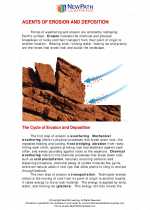Drumlins
Drumlins are a type of glacial landform that are often found in regions that were covered by ice sheets during the last ice age. They are elongated, tear-shaped mounds of glacial till that are typically aligned in the direction of the ice flow.
Formation of Drumlins
Drumlins are formed through the process of glaciation. As a glacier moves over the landscape, it picks up rocks, sediment, and other materials, which are then deposited as the glacier retreats. These deposits form the characteristic shape of drumlins, with a blunt end facing the direction from which the glacier advanced, and a tapered end pointing in the direction of the ice flow.
Characteristics of Drumlins
- Elonagted, tear-shaped mounds
- Composed of glacial till
- Aligned in the direction of ice flow
- Blunt end faces the direction of glacier advance
- Tapered end points in the direction of ice flow
Study Guide
Formation Process
Describe the formation process of drumlins, including the role of glaciation and the deposition of glacial till.
Characteristics
List and explain the main characteristics of drumlins, including their shape, composition, and alignment.
Comparison with Other Landforms
Compare and contrast drumlins with other glacial landforms, such as moraines and eskers, highlighting their unique features and formation processes.
Importance and Impact
Discuss the importance of drumlins in understanding past glacial activity and their impact on the current landscape.
By understanding the formation and characteristics of drumlins, we can gain valuable insights into the dynamic processes of glaciation and the shaping of the Earth's surface.
.◂Science Worksheets and Study Guides Seventh Grade. Agents of Erosion and Deposition

 Worksheet/Answer key
Worksheet/Answer key
 Worksheet/Answer key
Worksheet/Answer key
 Worksheet/Answer key
Worksheet/Answer key
 Vocabulary/Answer key
Vocabulary/Answer key
 Vocabulary/Answer key
Vocabulary/Answer key
 Vocabulary/Answer key
Vocabulary/Answer key
 Vocabulary/Answer key
Vocabulary/Answer key
